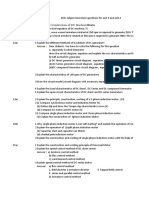0% found this document useful (0 votes)
17 views14 pagesProject Physics Transformer
The document is a physics project by Satyam Tiwari from PM Shri Kendriya Vidyalaya on the topic 'Working of Transformer and its Principle' for the academic year 2024-25. It covers the introduction, working principle, construction, types, applications, energy losses, and efficiency of transformers, emphasizing their importance in electrical engineering. The project concludes by highlighting the role of transformers in power transmission and consumer electronics, along with a bibliography of references used.
Uploaded by
ashishpandey5054270Copyright
© © All Rights Reserved
We take content rights seriously. If you suspect this is your content, claim it here.
Available Formats
Download as PDF, TXT or read online on Scribd
0% found this document useful (0 votes)
17 views14 pagesProject Physics Transformer
The document is a physics project by Satyam Tiwari from PM Shri Kendriya Vidyalaya on the topic 'Working of Transformer and its Principle' for the academic year 2024-25. It covers the introduction, working principle, construction, types, applications, energy losses, and efficiency of transformers, emphasizing their importance in electrical engineering. The project concludes by highlighting the role of transformers in power transmission and consumer electronics, along with a bibliography of references used.
Uploaded by
ashishpandey5054270Copyright
© © All Rights Reserved
We take content rights seriously. If you suspect this is your content, claim it here.
Available Formats
Download as PDF, TXT or read online on Scribd
/ 14



















































































